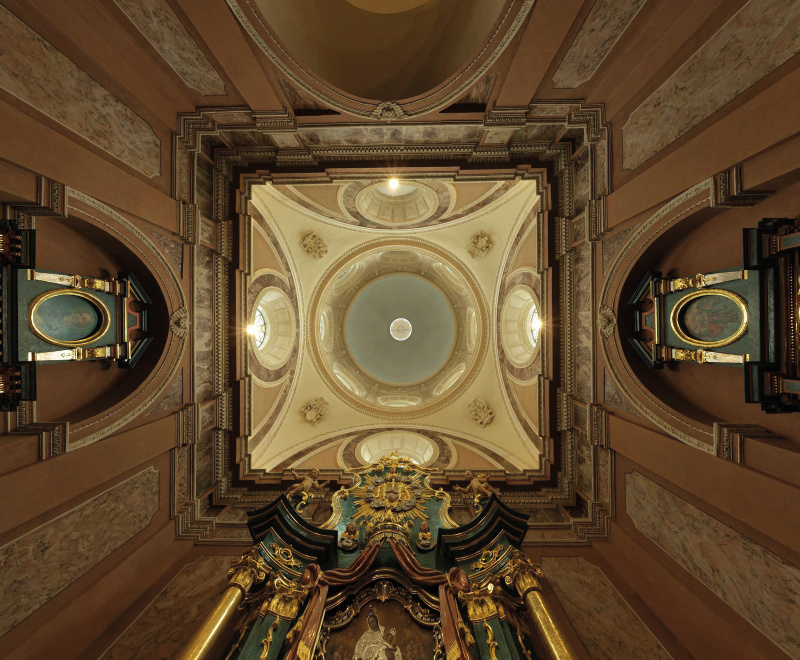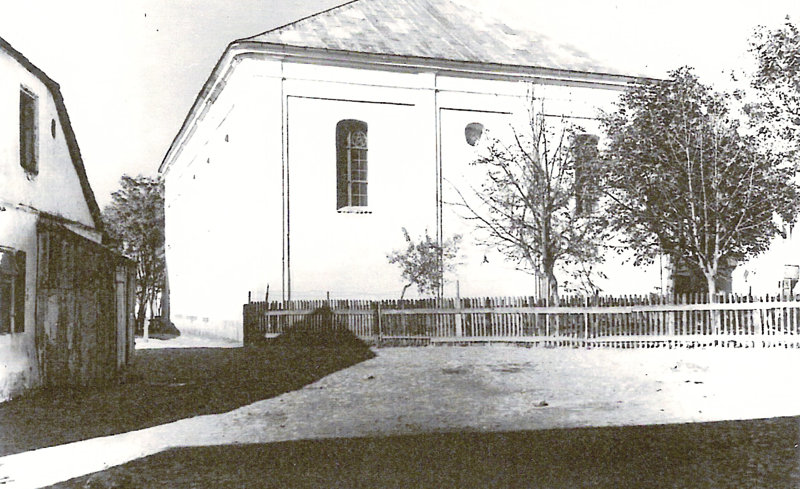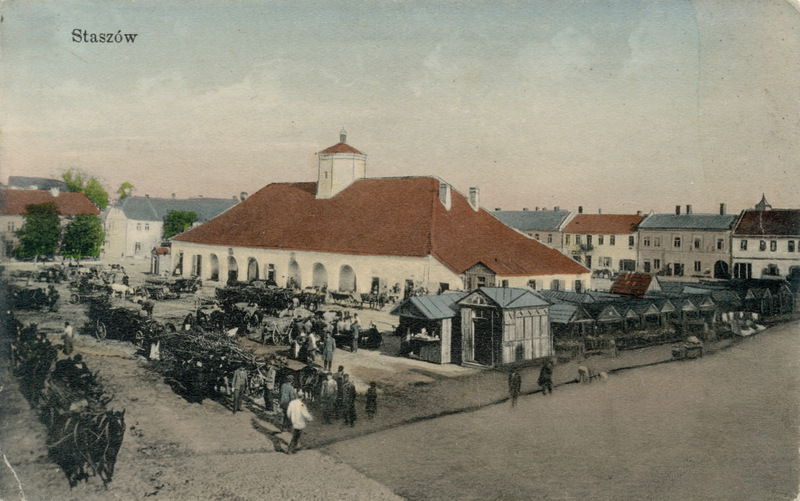
1539 - 1772
 |
| Holy Rosary Chapel, built in 1625 |
Following Hieronymus Łaski's death in 1541, ownership of Staszów was inherited by his firstborn son, Albert. In 1555, a weavers' guild was established in Staszów. It was the first guild of Staszów artisans.
In 1564 the town had 100 houses and more than 600 residents. In 1578 Staszów possessed its own iron forge, two mills, a sawmill, weaving mill, and 38 artisan workshops. Staszów's pottery and clothing articles were famous for their excellent quality.
In 1580, following the influence of Protestant Reformation, an Arian church was built in Staszów. However, very soon after its creation – in 1596 – it was repurposed into a Catholic church and dedicated to the Holy Spirit[7]. In the meantime, Staszów had become property of Tęczyński magnate family. Initially the town's ownership was in hands of Gabriel Tęczyński. After Gabriel, there was Andrzej Tęczyński, and since 1614 – Jan Tęczyński, the provincial governor of Kraków. Thanks to his efforts, the Holy Rosary Chapel was built next to the St. Bartholomew parish church. Its construction took place in years 1614-1615. That chapel is one of the most beautiful examples of Renaissance architecture and art remaining in Staszów region to this day[8].
Jan Tęczyński contributed immensely towards furthering the growth of Staszów's craft. During the first half of the 17th century Staszów was home to 1500 residents, including many craftsmen of various trades. Tęczyński had approved guilds of tailors, furriers and hatters in 1621. Four years later – in 1635 – the town's owner approved guilds of blacksmiths, brickmakers, saddlemakers, ropemakers, boilermakers, bladesmiths and goldsmiths[9]. Thanks to Jan Tęczyński, the St. Anne Literary Brotherhood was founded in 1622. The Brotherhood dealt with religious matters, but it also served an educational purpose. It was around that time that an elementary school was founded next to parish church – priests and missionaries were its teachers.
Following Jan Tęczyński's death in 1637, Staszów became the property of his daughter Izabela and her husband, Łukasz Opaliński of Bnin. Łukasz Opaliński was a notable figure of Polish Renaissance; he was the Grand Marshal of the Crown. During the Swedish Deluge he remained a faithful servant to king John II Casimir Vasa. In 1653 Opaliński successfully repelled George II Rákóczi's attack on his castle in Rytwiany. Łukasz Opaliński also focused on furthering the growth of Staszów's craftsmanship. In 1648 he approved the guild of clothiers, and in 1655 the shoemakers' guild.
After Opaliński's death in 1622, Staszów was inherited by his sons: first by Jan, and after his death – Stanisław Łukasz. Stanisław Łukasz Opaliński was an interesting figure. He married several times, one time to a peasant woman of Szczeka – Marianna Dziulanka. In 1670 he approved the potters' guild. In 1685 he joined the navy. During his absence Staszów was under the custody of his sister Anna Opalińska (wife to Stanisław Lubomirski), and later their daughter Elżbieta, wife to Adam Sieniawski. Adam Sieniawski was the Great Commander of the Crown. He participated in many battles, including the Battle of Vienna in 1683. He sided with Augustus II the Strong in his struggle against Stanisław Leszczyński for the throne of Poland.
In 1705 and in 1708 Staszów was struck by cholera outbreaks. In 1712 Staszów was invaded by Swedish troops participating in the Great Northern War – its main battlefield was Polish soil. Then-mayor of Staszów, Jan Gołąb, was captured by the Swedish troops.
 |
| Staszów synagogue |
In May, 1718 Elżbieta Sieniawska allowed Jews to once again settle in Staszów and build a synagogue with cemetery, after they were banished from Staszów more than a century earlier – in 1610 – for alleged ritual murder.
In 1726 Staszów became property of Maria Zofia Sieniawska. Her first husband was Stanisław Denhoff – province governor of Połock and Field Commander of Lithuania. Following his death in 1728, Sieniawska married August Aleksander Czartoryski, prince of Klewań and Żuków, who received Staszów and its surrounding area along with lands in Małopolska as his wife's dowry.
Staszów has August Aleksander to thank for the economic boom of 18th century. In 1738 Czartoryski finished the construction of Staszów's market (replacing the previous market built between 1690-1706), which had served a purely commercial purpose for many years.
Thanks to Czartoryski, the town's main streets and the market square were cobbled. Tenement houses, which remain in older parts of Staszów to this day, are the results of Czartoryski's construction operations. He also contributed greatly towards the development of clothiers' manufacture. That manufacture was comprised of several tens of workshops producing articles from cloth made of wool imported from the south of Poland. Thanks to prince's efforts a clothiers guild was founded in 1755, and a group of German specialists came to Staszów in 1760[10]. Prince Czartoryski also founded a sabersmith workshop which produced "staszówka" sabers, well-known across Poland of that time. Czartoryski also founded a copper forge which converted imported raw material into sheet metal and cauldrons[11].
During this time, Staszów was home to many artisans: tanners, saddlemakers, glovemakers, soapmakers, watchmakers, carriage-builders, locksmiths, blacksmiths, swordsmiths, shoemakers, bakers, tailors, millers, carpenters, potters, glaziers, goldsmiths, boilermakers, braziers, coopers.
 |
| Town fair at the Market Square built by August Aleksander Czartoryski in Staszów |
Near the end of the 18th century weekly fairs on Thursdays were already a well-established tradition in Staszów. Bigger fairs were held at Staszów market square 12 times a year. The Jewish community had played a big part in Staszów's commerce at that time; they had received privileges from prince Czartoryski in 1772, which guaranteed their legal participation in commerce and craft of Staszów[12].
The economic boom of the 18th century had also increased overall wealth and well-being of Staszów's residents. In years 1786-1787 Staszów as a whole had more than 300 households, including 31 brick houses. There were fourteen shops selling foreign products and numerous booths and stalls at the market square. Town's population numbered about 2500 residents.
Dariusz Kubalski Ph.D.
English translation by Michał Mróz
Archival pictures from the personal collection of W. Migoń
Footnotes:
[7] A. Bazak, Kościół pod wezwaniem Ducha Świętego w Staszowie Wotum za Papieża – Polaka Jana Pawła II, Sandomierz 2009, p. 23; AP Kielce ADS sign. 144
[8] A. Bazak, Parafia świętego Bartłomieja w Staszowie 1918-2000. Zarys dziejów, Sandomierz 2005, p. 41
[9] W. Siek, Opis historyczny miasta i parafii Staszów, Staszów 1990, p. 30-31
[10] A. Makowska, Prywatne miasto Staszów…, p. 122-123
[11] as above, p. 145
12] AP Kielce, Archiwum Dóbr Staszowskich, sign.


